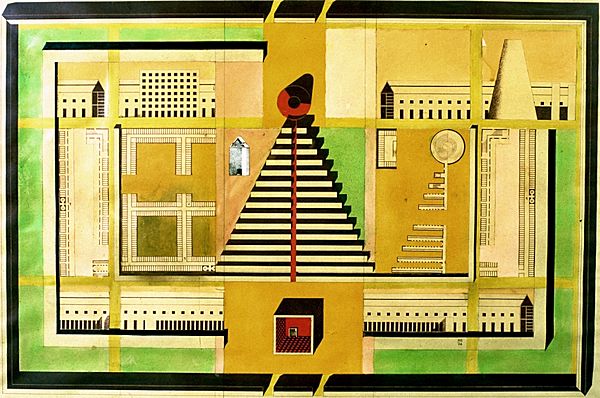Aldo Rossi: New cemetery in Modena, site plan, 1971
Aldo Rossi: Town-hall in Muggio, 1972
| |
Profoundly influenced by the ambivalence to Humanism in modern painting, Hejduk, like Le Corbusier, has nonetheless remained an architect bound to the mores of Humanism. Throughout his work he has been as incapable of emulating the multi-directional spatiality of the De Stijl or Suprematist movements, as he has been unable to abandon the Humanist emphasis on frontality, in which the illusory facade or frons scenae, stands for the whole world. His Babar and Wall Houses insist on this frontal mask--light on one side, dark on the other--and the undeniable poetry of Hejduk's art has lain in this opposition where the existential tragedy of being, seems to be evoked, with all its multiple associations, in passing through and beyond this double-sided facade in order to live. Emphasizing the mask rather than the face, Hejduk has acknowledged as an architect, the fatal and necessary links connecting inside to outside and vice versa. His incidental attempt within this Humanist paradigm to posit architecture as painting--the extreme position adopted in his Diamond House isometrics, has no broader cultural implication outside the aesthetic hermeticism of his graphic art.
So much for the frons scenae. For the other dimension of the Humanist tradition-namely the projection of the city--the lack of any urban significance in Hejduk's architecture stands in strong contrast to the work of Aldo Rossi, with whom Hejduk has become fortuitously but appropriately linked through the occasion of their joint exhibition and seminar held in the ETH Zurich in 1973. The work of Rossi demonstrates that the object and its context is as much the substance of architecture as it is the basis of metaphysics and in this respect no two architects could be more unalike. For where Rossi always predicates the containment of urban space and the monumentalization of the public realm, as the quintessential spatial and temporal continuity of architecture, Hejduk posits the ephemeral ideal of the isolated form against a limitless open horizon (c.f. the work of Frank Lloyd Wright). Where the one addresses the city-state and the collective, the other celebrates the heroics of the individual within a Rousseauesque landscape; where
the one asserts the historicity of the signoria, the other perpetuates the perennial myth of the prairie utopia. This opposition finds its semantic corollary in their respective
architecture, for where Rossi compounds form out of walls and windows which implacable enclose and differentiate the public and private realms, Hejduk projects the isolated wall as a datum whose formal raison d'etre is to stand as an optical field against which appointed objects (including
man) may be aesthetically arranged. Despite the comparable importance accorded by both men to the formal domain this evident ideological split could hardly be more decisive and pronounced, for where the one establishes, in palpable terms, the essential continuity of the society, the other celebrates' in Romantic vein, the essential discontinuity of the individual. The brilliance and the limits of Hejduk's achievement lies exactly at this juncture where the urbanistic work of Rossi emerges as a foil and a challenge to the formal and social isolation of Hejduk's architecture.

| |

|

